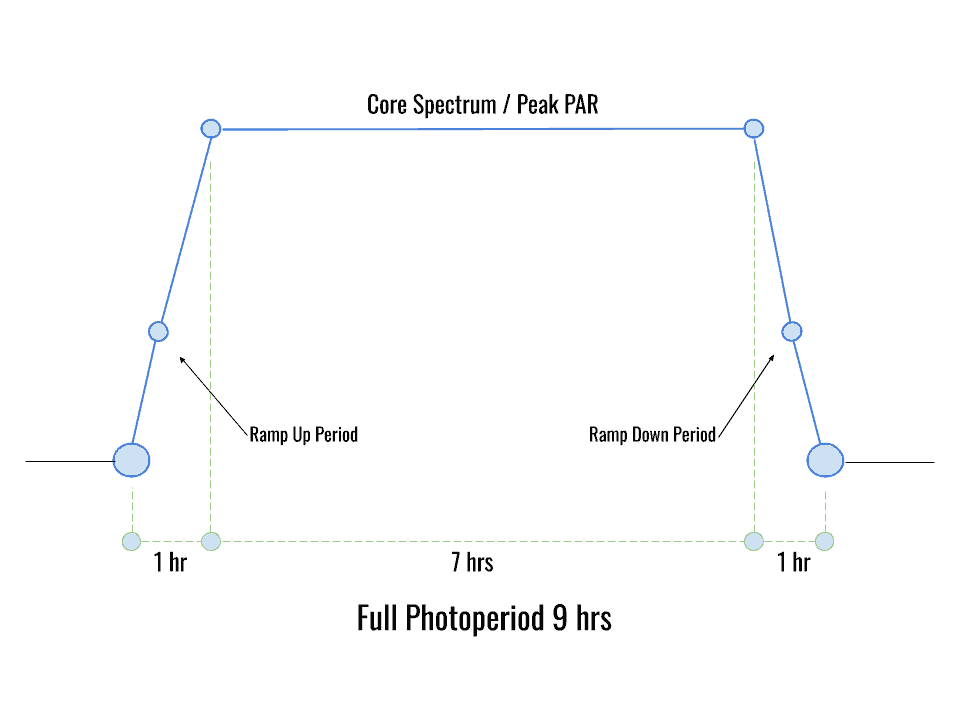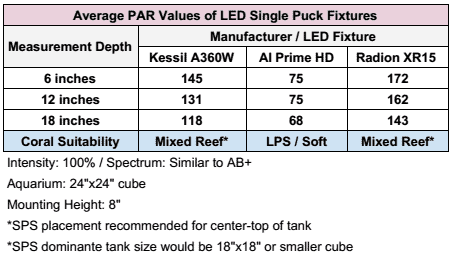How Much LED Lighting For Reef Tanks?
The corals contained within your reef tank will determine the spectrum and PAR required. I recommend a full photoperiod of 9 to 7 hours for the core spectrum and a one-hour ramp up and a one-hour ramp down. The recommended minimum range of photosynthetically active radiation (PAR) for each reef tank type is as follows:
- SPS-dominated tanks: 250-350
- Mixed reef tanks: 75-350
- LPS-dominated tanks: 50-150
- Soft coral-dominated tanks: 50-100
Lighting is of utmost importance to a reef tank. Lighting for reef tanks is all about the spectrum and PAR. Combined with water parameters and water flow, lighting is a part of the most important trinity of your reef tank. So let’s get straight to it!
Related Article: Best Reef Lighting Showdown 2023
Why use LED lighting for Reef Tanks?
Advantages of LED lighting include:
- Never having to buy replacement bulbs
- Lights run cooler, which can help keep your tank cooler.
- LEDs are more energy-efficient and have a smaller carbon footprint.
- Spectrum and intensity are fully customizable.
- Stable light quality over time.
- Interesting lighting effects include simulating the sun’s movement, thunderstorms, and more.
- Fixtures are generally a small form factor and are aesthetically appealing.
Check out my post for a proven process to select the right LED fixture.
Best Reef Lighting: Maximize Coloration and Growth with LED Lighting
LED lighting for reef tanks should be focused on 3 key elements
- Power intensity: The ability of the LED to provide the necessary PAR. It’s best to have a fixture to provide the PAR required by the corals you have or plan to add to your reef tank.
- Light distribution: A widely dispersed light is preferred. You will want to have your light mounted to optimize the light throughout the tank. Good light distribution may require multiple fixtures or fixtures with multiple LED pucks. Avoid large hotspot areas of super high intensity.
- Spectrum: The mix of LED channels provides the color spectrum for proper coral metabolism functions. SPS, LPS, and soft corals all perform differently under different spectrums.
The bare minimum requirements are the PAR, spectrum, and distribution necessary to support your corals’ metabolic functions. Most aquarists don’t just want their corals to survive but thrive with explosive growth and beautiful coloration.
The sad news is that you are likelier to kill your corals with LED lights than create a stunning reef tank. This is because more PAR is not necessarily better! The powerful LEDs on the market today can provide 2-3 times the intensity required for your corals. Check out my article here if you are having trouble with your corals not opening or extending.
You want to provide the right amount of PAR – without triggering defense mechanisms in the coral that stunt growth and ruin colorization. Start at a lower intensity setting, say 50%, and build your intensity to the recommended levels at the start of this post.
Adjust your lighting over a period of months – not days. Wild swings in spectrum or intensity can completely screw up your corals. Take your time and make adjustments slowly.
Best Reef Tank Lighting Schedule
I recommend a full reef tank photoperiod of 9 hours. I suggest you create a 7-hour period under the core spectrum at your selected PAR. The other 2 hours of the photoperiod consist of a 1-hour ramp up and a 1-hour ramp down.

The ramp-up period takes the reef lighting in the aquarium from dark (0%) up to the core spectrum intensity. The ramp-down period returns the lighting from the core spectrum intensity to dark (0%). The PAR of the core spectrum period will depend on the corals in your reef tank.
The recommendation for the photoperiod comes from testing performed at professional aquaculture facilities. EcoTech Marine, in conjunction with Reef Wholesale, produced a case study on LED lighting. The results included accelerated growth and beautiful coloration.
What if you want to run a longer photoperiod?
Lower your PAR values to run a longer photoperiod! It is that easy. Those who do not have access to see our tank throughout the day usually have no issue running a shorter photoperiod. However, if you want to run a longer photoperiod, the EcoTech Marine case study with World Wide Corals guides photoperiods around 12 hours.
The intensity setting of the core spectrum photoperiod will also depend on your LED fixture(s). Top-end performance LEDs such as EcoTech Marine’s Radion G4 Pro fixtures and Kessil’s A360X and AP700 fixtures should not be run at 100% intensity. An intensity between 50% and 80% will likely provide all the PAR required for your corals.
Aquarium light diffuser
When running a diffuser, an LED fixture will lose up to about 20% of PAR. If you run a diffuser, you must increase the light intensity to overcome PAR drop. This means you will need to run at a higher intensity with a diffuser to provide the same PAR level as without the diffuser.
Photosynthetically Active Radiation (PAR)
The PAR value will vary depending on the distance from the light source. This distance is taken in every direction. PAR values are typically measured at depths such as 6”, 12”, and 18”.
The PAR value measured at 6” below the water line is likely substantially higher than the 12” and 18” readings. The chart below illustrates the average PAR value for 3 of the major LED lighting manufacturers at various water depths.

Aquarists place their corals with this understanding of PAR variance, allowing them various corals with different PAR requirements. Even among SPS corals, for example, PAR requirements can vary by as much as 100+ PAR.
Place corals requiring the highest intensity near the top of the tank. Place corals requiring the least PAR at the bottom. This is the proper coral placement method whether your tank is SPS, LPS, Softies, or Mixed. Those that like the most PAR should be closer to the light source.
The table (Fig. 2) above shows that the Kessil A360W and the Radion XR15W can support SPS corals in the aquarium’s uppermost center, where PAR is within the recommended 250-350 range. The PAR drops as you move away from the center or deeper in the tank.
I don’t recommend the Aqua Illumination Prime HD for any SPS or mixed tank setups using a single puck unless the aquarium cube size is 12″ x 12″.
To have SPS-dominant tanks with the Kessil A360W or the Radion XR15W, you would need to go with a smaller tank, such as an 18″ x 18″ cube or even smaller. The other option would be adding a fixture or changing to a two-puck fixture, such as the Kessil AP700 or the Radion XR30W.
Aquarium PAR Meters
The best situation is determining the PAR levels for your specific tank. The best methods for testing PAR in your own tank may not match your financial capabilities, so here are a few ideas on measuring PAR in your tank with associated costs.
You can purchase LED PAR meters from Apogee or Seneye. The Apogee MQ-210 Underwater Quantum PAR meters are about $429 at Amazon. Check price.
The Seneye par meter is a part of the Seneye Reef Monitor. The Reef Monitor is about $229 on Amazon. Check price. In addition to having a PAR monitor, the Seneye has many valuable uses for a reef tank.
- Temperature: continually monitors water temperature and alerts you if there is an issue, such as your heater breaks or your chiller fails
- Free Ammonia: monitors the highly toxic free ammonia (NH3) at shallow levels. Never worry about your fish dying from Ammonia poisoning.
- pH: monitors pH in your aquarium.
- Others, such as water level, LUX, and Kelvin
If you have an APEX Aquarium Controller, you can get the Apex PAR Monitoring Kit for about $299. Check price.
If you are lucky, your local reef community may have a PAR meter that members can check out a week at a time. Bulk Reef Supply will rent PAR meters as well. You can rent it here but must return it within 7 days to get your full deposit.
Nano Reef Lighting Schedule
How much LED lighting for reef tanks? I recommend a full reef tank photoperiod of 9 hours for nano tanks. 7 hours for the core spectrum, a one-hour ramp up, and a one-hour ramp down to begin and end the daily light cycle.
The lighting schedule of a nano reef tank is generally the same for larger reef tanks.
If you purchased a nano tank kit, you are likely using the LED lighting that came with the kit. Since you rely on a fixture included as part of a kit, you may be unable to set complicated schedules and/or adjust the lighting spectrum.
In that case, it is extremely critical that you only purchase corals that will thrive under the given PAR and spectrum of your lighting. Using the Coralife LED Biocube 32 as an example, the maximum PAR at 12” below the fixture is 81, and the average PAR at 12” below the fixture is 53.

LED Biocube 32 – working with OEM lighting
The Biocube LEDs are essentially white and actinic. The lid has built-in timer controls that allow you to run two different levels of white and one level of actinic or blue light.
The settings will allow you to ramp up using the blue LEDs, then the blue LEDs with the addition of a portion of the white LEDs, and then all of the white LEDs with all of the blues for the core spectrum period. A similar ramp-down sequence would return the tank to darkness. There are no controls to adjust the spectrum.
That PAR level is adequate for soft corals such as Nephthea tree corals, star polyps, xenia, toadstools, pipe organs, Sinularia, and mushrooms. You can also include many LPS corals, especially in the aquarium zone between the 6” and 12” depths when medium light levels are required. These corals include bubble coral, Duncans, Acanthastrea, Blastomussa, Scolymia, and Euphyllia corals, such as hammers, torches frogspawn. Zoanthids would also work fine at these PAR values and are available in mind-blowing colors. Between the soft corals, zoanthids, and LPS, there are hundreds of corals to choose from to create an exciting nano reef tank.
The likelihood of successfully keeping SPS corals such as Acropora in the Biocube is near zero for the average aquarist. Unfortunately, everyone wants the one coral they cannot have. Many Biocube and other nano reef tank builds show upgraded lighting.
However, upgrading the lighting, including mounts, diffusers, etc., is expensive to add a handful of coral to the tank that couldn’t exist under the OEM LEDs.
Summary: How Much LED Lighting For Reef Tanks?
The corals you have or plan to add to your reef tank will determine how much LED light you need for your reef tank.
The recommended amount of photosynthetically active radiation (PAR) for each reef tank type is as follows:
- SPS-dominated tanks: 250-350
- Mixed reef tanks: 75-350
- LPS-dominated tanks: 50-150
- Soft coral-dominated tanks: 50-100
I recommend a full photoperiod of 9 hours for reef tanks. The photoperiod consists of 7 hours for the core spectrum, a one-hour ramp up, and a one-hour ramp down.
If you purchase an aquarium kit with lighting included, you must determine the spectrum and PAR provided to determine what corals can be successfully maintained. The easiest reef tank to maintain is where the aquarist stays within the boundaries of their tank.
That is why it is always best practice to determine the fish and corals you plan to have in your tank BEFORE purchasing your equipment.
Additionally, equipment for measuring PAR is available for rent or purchase and the opportunity to build your own PAR meter.